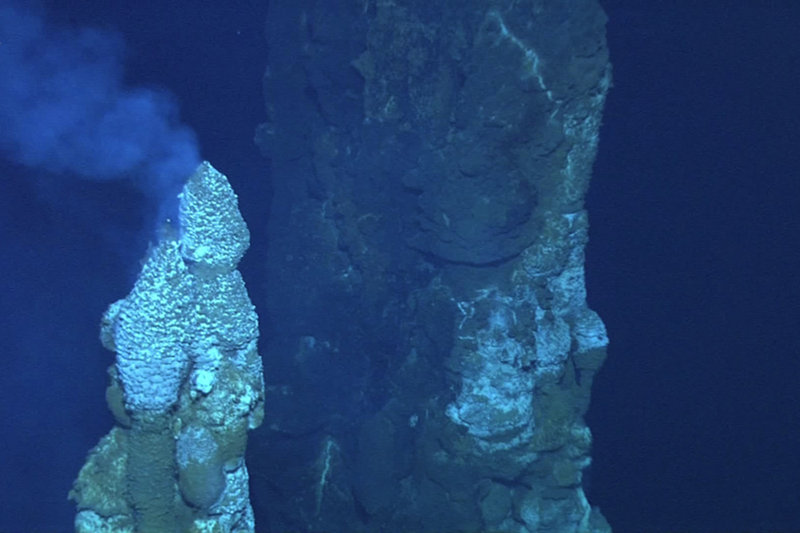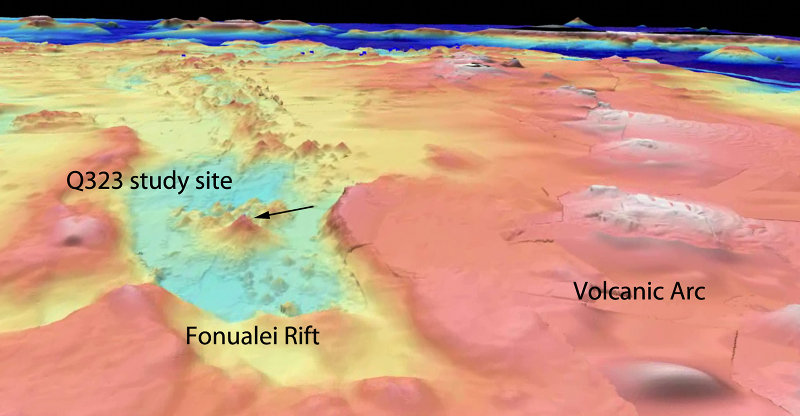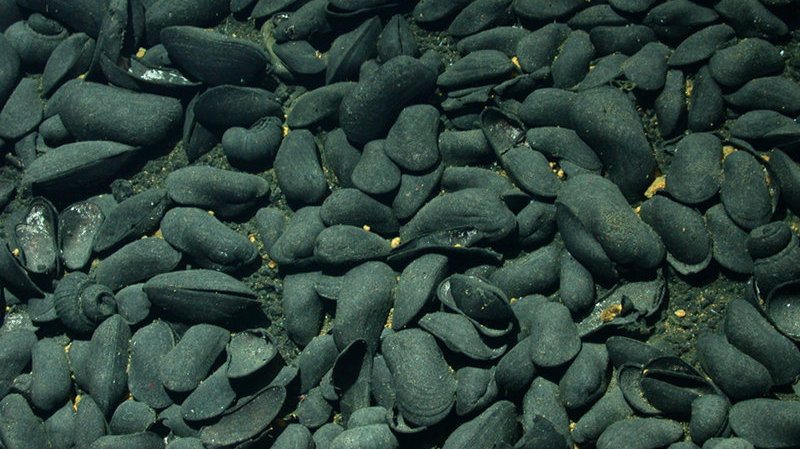
By Ken Rubin, Professor of Geology and Geophysics - University of Hawaii, Manoa
and Paula Keener, Director, Education Programs, - NOAA Ocean Exploration & Research
September 13, 2012
1619 GMT
Wind – NE @ 5 kts
Air Temperature – 25.9°C (78.7°F)
Sea State – 2.2m
Subduction systems such as the Tonga Arc/Lau Back Arc Basins host multiple volcanic environments. The two most common ones are subduction zone volcanoes at the arc and spreading center volcanoes in the back arc (see Submarine Volcanoes of the NE Lau for more information). The first two dive sites of the Submarine Ring of Fire 2012 Northeast Lau Basin Expedition occurred in interesting volcanic environments at the convergence of these two settings, producing volcanoes that are expected to be hybrids of the two.

Large chimneys discovered at Fonualei Rift. These spires, reaching 35-40 m in height, formed close to each other at a depth of 1,555 m. Image courtesy of MARUM, University of Bremen and NOAA-Pacific Marine Environmental Laboratory. Download larger version (jpg, 713 KB).
Where are these hybrid volcanoes found? Near the tips of backarc spreading ridges that have propagated (cracked) through the crust to a point where they nearly intersect the arc. These sites are found at the southern tips of two different Lau back-arc spreading centers, at Vai Lili, near the southern tip of the Valu Fa ridge for Dive Q322 (September 11th dive site) and at an unnamed volcanic cone near the southern terminus of the Fonualei Rift (pronounced fo-nu-ah-lay) for Dive Q323, where we dove today.

Satellite altimetry and multibeam sonar image of Fonualei Rift and dive site. Image courtesy of Susan Merle, Oregon State University/NOAA Vents Program. Download larger version (jpg, 578 KB).
The main objectives of these dives were a bit different; however both of them examined warm or hot volcanic springs and the organisms living, and the remnants of those who had once lived, around them. It turns out that volcanism at the arc is formed from something called flux melting, where water released from the subducting plate causes melting in the mantle of the over-riding plate. By contrast, spreading center magmas are formed by decompression of rising mantle in response to stretching of the shallow lithosphere. These two very different processes result in quite different magma chemistry, which in turn imparts its particular flavor to the hydrothermal activity. Hybrid zone volcanoes should erupt magmas that are mixtures of the two. It will be fascinating to learn if the rocks, fluids and life at these hybrid volcanoes do in fact sit at the compositional intersection of these two different volcanic domains.
Shortly after arriving on the seafloor at a depth of 975 meters this morning, the cameras mounted on MARUM’s Quest 4000 revealed small lava towers approximately 5-10 m in height with steep walls rising from the seafloor at Fonualei Rift. Some pillow lava was observed at their bases along with large areas of diffuse clear fluid flow and areas covered with iron oxide bacterial mats. A few shrimp, crinoids, crabs, sponges, soft corals, and small fish were also seen, along with some shell fragments and a few anemones. Several rock samples were collected at the site.
Nearby, a second site revealed large expanses of dead mussel shells (the majority with valves closed) and gastropods shells. Almost all the shells were black because they were coated with manganese from previous hydrothermal venting. In most places, that venting had ceased, leaving these vast areas of dead shells. On the ridge tops, however, we found active chimneys with vent organisms living on them or nearby. Temperature at the chimneys measured 50°C. Eel pouts swam in an out of the field of view. A few of the scientists stated that they had not previously seen such a large expanse of bivalve shells at a vent site. Several bivalves were collected, along with what appeared to be a brachyuran crab. A scientist in the ROV van remarked, “We never know what we are going to find out here…this was certainly a surprise!“

A site at Fonualei Rift revealed large expanses of dead mussel shells (the majority with valves closed) and gastropods and shells at the base of several sulfide chimneys. Image courtesy of MARUM, University of Bremen and NOAA-Pacific Marine Environmental Laboratory. Download larger version (jpg, 2.0 MB).

Snails, commonly referred to as hairy snails, clustered on a sulfide chimney at Fonualei Rift. Image courtesy of MARUM, University of Bremen and NOAA-Pacific Marine Environmental Laboratory. Download larger version (jpg, 1.3 MB).
As we continued to explore the area, the Quest 4000 came upon a large area of white bacterial mats, overlaying mixed lavas and sediment and occasional pillow lava formations. Shimmering water was also observed in a few places, and generally, the water appeared to be murky. As the Quest 4000 continued to explore the site, a most spectacular vent field came into view with large chimneys reaching 35-40 m in height in proximity to each other at a depth of 1,555 m. Some were emitting smokey-looking hydrothermal fluids, the temperature of one measuring 254°C. Snails, crinoids, brachyuran crabs, scale worms, shrimp, spiny gastropods, and limpets were found along the chimneys in the areas of active venting. Shrimp, sediment, bacterial mats, and a water sample were collected. The site was named Loloa Kakai, which means “tall people“ in Tongan, evocative of the thin, tall chimneys situated close to each other that were discovered that this site. The dive concluded at 1,592 m.
These hydrothermal emissions from the seafloor and associated mineral deposits will eventually die out at this site. Until that time, the small clusters of organisms seen at Fonualei Rift cling to life as they cluster near the last warm water seeping to the surface from the interior of the Earth itself. What we have seen today is evidence of how very dependent vent organisms are on the volcanic cycles taking place well below the surface of the ocean.